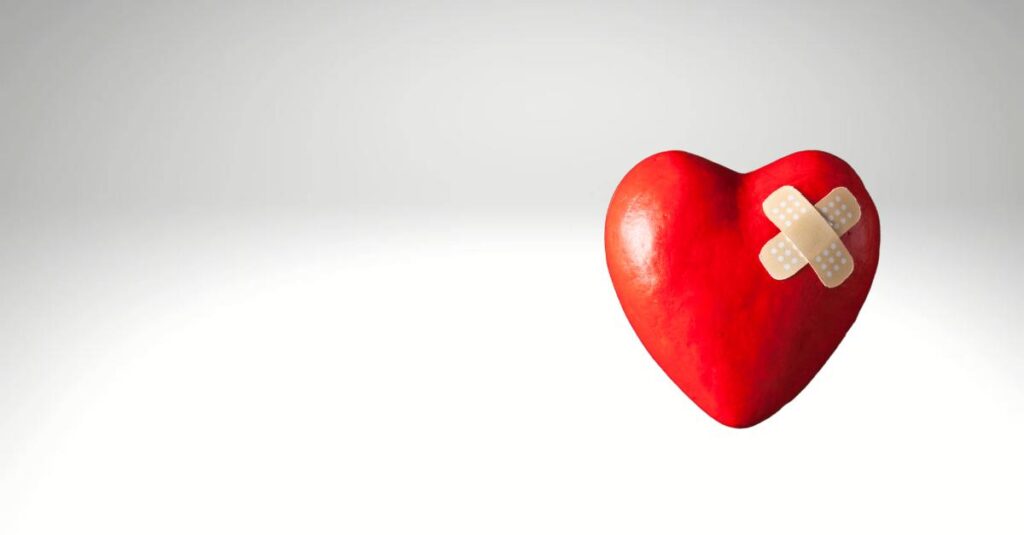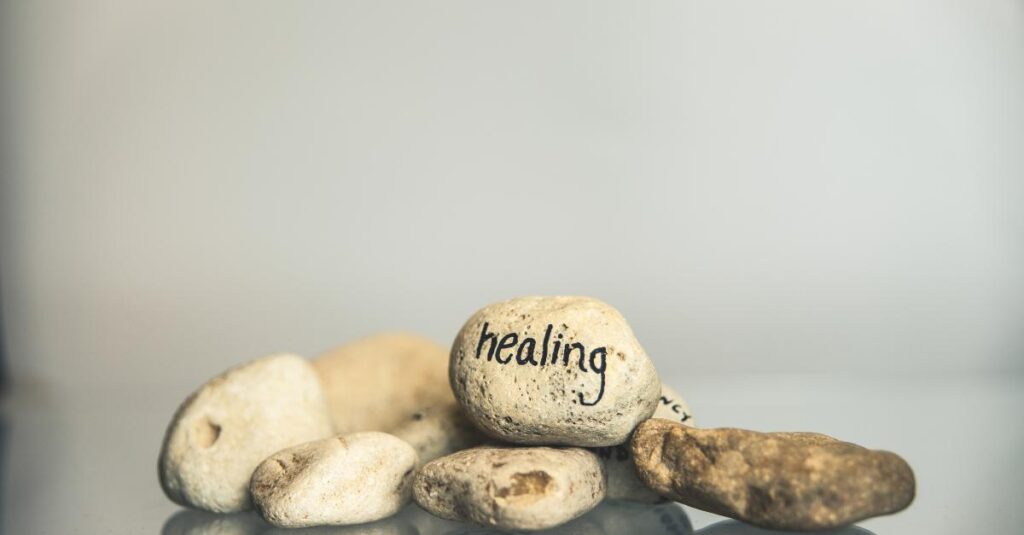Emotional Healing Then and Now
Our schools were equipped to make us book-smart, but emotional healing was never a part of the curriculum. Endless school days filled with math, science, and history?
We were learning about everything under the sun—except how to manage what was happening inside of us. We were taught how to solve equations, but no one ever handed us a formula for dealing with sadness, anger, or disappointment, and now regret. Emotions were considered distractions and nuisances.
If you cried in class, the solution was simple- stop crying.
I grew up as a child sensitive to emotions.
Like many, I was not encouraged to express, reciprocate, or talk about emotions.
There was an unspoken expectation to be emotionless.
Emotional healing? Forget about it. Emotional vocabulary? Negligent.
Emotional healing wasn’t discussed in homes, let alone schools.
Four decades ago, mental health wasn’t exactly the hot topic it is today.
It’s sad but funny how we were expected to handle life’s ups and downs with nothing more than a stiff upper lip and a ‘get on with it’ attitude.
Having spent the last decade in personal development, I can tell you this much—things are changing.
Mental health awareness is growing, and people are starting to understand the value of emotional healing and the importance of consulting a mental health professional. But for most of us, emotional education came way too late.
Now, midlife is when we get to play catch-up.
What is Emotional Healing?
Emotional abuse, bullying, and other non-physical harmful behaviors are far more common than we often acknowledge.
Unfortunately, many of us may stay stuck with negative patterns and emotions and may not progress in life even after coming out of such situations.
Emotional healing is the process of recognizing, accepting, and working through negative emotions, unprocessed feelings, or traumatic experiences.
These can stem from a variety of painful life experiences such as loss, failure, childhood trauma, or even the daily stress of life.
Emotional healing enables one to cope with these experiences, release negative patterns, and grow emotionally stronger.
An emotionally healed person is not controlled or overwhelmed by emotions.
They can acknowledge their feelings without letting those feelings dictate their actions or perceptions.
It is not about erasing the past but about finding peace with it.
My struggle with my own emotions and my quest to find the answers took me to many courses, modalities, and people.
Understanding Emotional Trauma
The word trauma came into my vocabulary in my 30s. I used to think it was meant to describe bad events or negative episodes caused by cruel, not-so-understanding people in your life. Later on, when I began reading and understanding it – I felt Emotional trauma is like this big, overwhelming thing that’s hard to understand and should be best left to professionals to treat and deal with.
Trauma can show up in all kinds of ways—maybe it’s emotional pain that never really goes away, or perhaps it’s anxiety, depression, or even PTSD. Post traumatic stress disorder (PTSD) is a serious mental health condition that arises from experiencing trauma, characterized by symptoms such as flashbacks, severe anxiety, and uncontrollable thoughts about the traumatic event.
From making people stutter to totally making them incapable of facing people, emotional trauma impacts people differently.
But for my quest to understand it, I broke it down into the severity of a painful event. Trauma is not something you can just “get over” or “move on” from, like a bad haircut.
Healing from emotional trauma is a process, and it’s a journey that takes time and mainly the involvement of a professional.
Healing from severe emotional trauma is not in the scope of the article that I am writing.
I’m sharing my experiences of healing emotionally from the challenges I created—whether through my own beliefs or my reactions to things I couldn’t control.
The Emotional Healing Journey
If there’s one thing I’ve learned, there’s no one-size-fits-all approach to personal development. Emotional healing is no exception. The process of emotional healing varies from person to person.
Some people find clarity through therapy, others might heal emotionally through journaling, meditation, yoga, or spiritual practices.
The trick is figuring out what resonates with you—a personal process.
While some may find relief through therapy, others might heal emotionally through spiritual practices like meditation or journaling. Regardless of the method, there are common steps in the healing process:
Awareness:
We have walked along life’s path feeling innumerable emotions yet do not exactly know what we think.
The first step in emotional healing is becoming aware of the emotions we are dealing with. Acknowledging these feelings, whether anger, sadness, guilt, or fear, is crucial.
Developing emotional vocabulary:
Awareness by itself isn’t enough if you cannot name what you are feeling. Developing an emotional vocabulary is the foundation for the emotional healing process.
Acceptance:
Once aware of our emotions, behind the bumpy ride of denial. It is not easy, but it is extremely important to accept what we feel.
Emotional healing can only begin when you accept that it’s okay to feel what you’re feeling.
Suppressing emotions complicates things and only leads to more emotional and mental strain.
Release:
After accepting the emotions, it is time to let it go. Holding onto emotions can be toxic and interferes with the healing process. It is like you cannot clean your hands while holding mud in it. Releasing emotional baggage might involve crying, talking to a trusted friend, or even engaging in physical activities that help lighten the emotional weight. Addressing emotional pain can also alleviate physical symptoms such as headaches, muscle tension, and fatigue, which are often manifestations of unresolved emotional issues.
Growth:
As you release emotional pain, you create space for personal development. Emotional healing leads to greater self-awareness, resilience, and the ability to set healthier emotional boundaries. This journey helps transform you into a less self-abusive person.
Rebuilding:
Healing emotionally also means learning how to rebuild your emotional foundation. This involves replacing old, harmful thought patterns with positive, constructive ones. Over time, this helps create a sense of emotional stability.
Why Emotional Healing Becomes A Necessity in Midlife
As women, we spend our younger years juggling various roles—daughter, partner, mother, employee, business owner—often putting our emotional needs on the back burner.
We are so busy ensuring everyone else is taken care of that our emotional health gets sidelined.
Midlife, though, has a way of handing you a magnifying glass, making you confront what’s been lurking in the background all along. Ignoring emotional health can also take a toll on physical health, leading to issues such as high blood pressure, heart disease, and other stress-related conditions. Old wounds, unspoken disappointments, unfulfilled dreams—they all have a way of bubbling to the surface.
It’s a time when you’re navigating major life changes -kids moving out, career shifts, health concerns and suddenly, there’s this space.
A quiet space where all those ignored emotions finally decide it’s their turn to be heard.
And here’s the thing—ignoring them doesn’t really work. Trust me, I tried.
I remember getting angry on many occasions. An angry woman is not exactly celebrated in our society—while an angry man earns fame, even a poster spot in Bollywood or Hollywood. I would be angry about not being heard, about boundaries being crossed, and about my decisions and choices not being considered. I carried that anger through life, all while having fun, raising a family, and pursuing hobbies.
But anger doesn’t just fade away—it changes. It morphs into regret, and regret brings hopelessness. Pretty soon, you might find yourself facing full-on depression. Thankfully, I was self-aware enough not to let things escalate that far.
Midlife, then, becomes the perfect time to roll up our sleeves and do the work we’ve postponed for decades. The most important reason healing is important in midlife is so that you can embark on the journey to designing your future with a cleaner emotional slate.
Here’s the truth: midlife finally gives us the space to acknowledge those emotions, and that’s the first step to healing.
Recognizing the Signs: Are You Carrying Emotional Baggage?
We all carry a little emotional baggage, but midlife has a way of making that baggage feel extra heavy. The trick is recognizing it before it starts weighing you down too much. But how do you know if you’re lugging around unresolved emotions?
Well, if you find yourself getting unusually frustrated over small things, or maybe feeling like there’s a constant undercurrent of emotional distress or sadness—those could be signs. Or, if you’re replaying old conversations in your head, thinking about what you should have said, that’s probably some emotional baggage too.
Check if you’re carrying negative thought patterns
For me, it was the random bursts of anger or frustration that tipped me off. I wasn’t mad at the present moment, but at unresolved situations from years ago. I’d get triggered by something small, and suddenly, all those unspoken emotions from the past would come flooding back. Let’s face it, getting upset over a dirty mug in the sink is rarely about the mug itself.
The thing is, emotional baggage doesn’t always announce itself with a big, loud entrance. It often shows up in subtle ways—like that little voice in the back of your mind saying, “Remember that time when…?”
And these patterns are enough to:
- Drain your energy
- Keep you stuck,
- Make you doubt yourself,
- And send your dreams and goals for a toss—yet again.
Recognizing these signs is the first step to lightening the load. Those feelings aren’t always about the present—they’re often unresolved emotions from the past. And that’s okay. The key is catching them before they start to weigh you down.
How Do You Heal Emotionally?
To heal emotionally, as I said earlier, there’s no one-size-fits-all answer. It only takes finding out what works for each one of us.
Unfortunately, a few opt to drown themselves in unproductive and damaging coping mechanisms. Because it takes time, patience, and willingness to figure out what works for you—solutions abound in today’s world.
Therapy and Counseling:
More than ever, this world has many Professional therapies, such as cognitive behavioral therapy (CBT), Hypnotherapy, Reiki, Chakra, Crystal, and many more, that can help you emotionally heal.
I found it helpful to occasionally talk to coaches and counselors, who gave me another support layer. Counselors sometimes work, too, as they help unpack your emotions in a safe and nonjudgmental space.
Journaling:
I have been scribbling ever since I remember. Journaling came unknowingly in my life and stayed with me forever. Putting abstract emotions into words on paper was both cathartic and therapeutic. Writing helped me build and understand my emotional vocabulary.
It is so easy to bare the soul to a non-judgemental white paper and a pen—more on journaling here.
Meditation
Meditation unwittingly evokes the image of a monk sitting in a quiet space. For me, that has not worked as much.
I’ll be honest—sitting still for 10 minutes of meditation to quieten my mind didn’t work for me at first. So, I leaned into guided meditations. I loved them so much that I eventually started making my own tapes on guided meditation and affirmations.
Guided meditation and affirmations help quieten negative thoughts and imprint positive, productive thought patterns. This is my deal!
Physical Activity
Exercise releases endorphins- which are the body’s natural mood boosters- says Google.
Honestly, exercising takes motivation, but you have to do what you have to do. I like lifting weights, which I do with the help of a trainer who ensures I do not cheat on my reps.
Physical fitness and emotional health go hand in hand.
Emotional Support:
Sometimes, just having someone to talk to—whether it’s a close friend, family member, or support group—can be incredibly healing. Having a support system is crucial, especially when dealing with the aftermath of traumatic events such as loss, abuse, or heart-breaks.
Emotional healing often requires not isolating ourselves but rather leaning on those we trust.
Let’s Not Complicate the Emotional Healing journey
The day I realised my frequent bursts of anger and irritability may be due to unresolved issues from the past; my quest was to work on this like a project.
“Stop being angry.”
“Avoid being nervous”,
They are all well-meaning advice, but emotions do not work obediently. You say it, and they do it!
That is why emotional healing is a complex journey.
Overwhelming too.
It is a balancing act to not be too hard on yourself yet firm enough to break the pattern.
Hence, the best thing to do is break down the whole process into simple, manageable steps.
No pressure, no rush.
Emotional healing doesn’t have to be some grand, transformative experience.
Sometimes, it’s as simple as pausing to take a deep breath when you feel overwhelmed. Or permitting yourself to feel whatever you’re feeling in the moment. It can be as small as a 10-minute meditation or as big as confronting a painful memory.
Emotional Healing is about Progress, not Perfection.
It is entirely personal. Whatever path you take, it’s valid. The key is to start where you are and follow the path that feels right for you.
The Emotional Healing Journey is not a Solo Endeavor.
Seeking support from loved ones, support groups, and mental health professionals can provide a sense of community and connection. By surrounding oneself with positive and supportive people, individuals can feel empowered and motivated to continue the healing journey.
Overcoming Obstacles to Healing
Getting past the hurdles on your healing journey is a big part.
Our mind is a smooth talker, ensuring we sabotage our progress if we are not watchful.
You will indulge in negative self-talk.
You will go through self-blame.
You will also feel shame.
I remember going to the very first therapist in my life after my postpartum. Postpartum depression can be a traumatic event that significantly impacts emotional well-being, making professional support essential for recovery. I felt so good in the session, unloading and reliving years of pent-up emotions that I had simply brushed under the carpet.
But next day, I was feeling ashamed about opening up.
I blamed myself for being vulnerable and weak.
I convinced myself that I was weak since I could not get a hold of my emotions.
The fact is that post-delivery, a woman’s mind, body, and soul pretty much shift at the core. The doctor says hormonal changes. Medical science can name it and recognise it in biological terms, but in our hearts, we know what we feel.
To get over these obstacles, practicing self-compassion is critical.
That inner critic needs to be sushed.
Play positive Poly to negative Nancy.
For every pessimistic quip, reframe a positive and empowering statement.
Working with mental health professionals or coaches can also be very helpful—they can guide you through the tough spots and give you the support you need to break down those walls.
Indulge in self-care.
There’s No Deadline for Emotional Health: Starting Wherever You Are
Emotional healing doesn’t have a time limit, like some emotional expiration date.
You can start whenever you’re ready; yes, midlife is as good a time as any.
Midlife is often the perfect time to start.
With the wisdom of age under your belt, you better understand yourself, your triggers, and your patterns.
You’re not reacting as much; you’re reflecting. You’re ready to release the baggage but at your own pace.
The beauty of emotional healing is that it’s an ongoing process, not a race to the finish line.
It’s about progress, not perfection.
It’s about taking those small, manageable steps toward lightening your emotional load.
And it doesn’t matter if you start today, tomorrow, or next year—what matters is that you start.
I used to think there was a window of opportunity for healing, and if I missed it, I was doomed to carry my baggage forever. But guess what? That’s not how it works. Healing can begin at any age, at any stage of life. The important thing is to be kind to yourself and start where you are—no pressure, no rush.
The Gift of Emotional Freedom: Reclaiming Your Power
There’s something incredibly freeing about emotional healing. It’s like finally putting down a heavy bag you didn’t realize you were carrying for so long. Once you start letting go of the emotional weight, you reclaim a sense of power over your own life.
Emotional freedom isn’t about erasing the past. It’s about accepting that the past happened, but it doesn’t have to dictate how you feel today. It’s when you realize you’re no longer at the mercy of old wounds or regrets. That’s when things start to shift.
For me, emotional freedom meant permitting myself to feel everything—the good, the bad, and everything in between—without letting it define me. In doing so, I started feeling lighter and more in control of my narrative.
Reclaiming your emotional power is about taking responsibility for your feelings, but not in a way that blames or shames you. It’s about understanding that you have the power to decide how you respond to the things that have shaped you.
And here’s the best part: emotional freedom doesn’t just change how you feel—it changes how you show up in the world. When unresolved feelings no longer weigh you down, you start living more authentically, more in line with who you are.
Embracing the Journey: Healing Is Messy, But Worth It
Emotional healing is not linear, and it’s not perfect.You got to be gentle with yourself on the tough days and celebrating the small victories. It is important to keep moving forward, even when it’s hard.
The messy parts are worth it because, on the other side of that mess, you’ll find emotional freedom, self-compassion, and a life that feels a little lighter, a little brighter.
Embracing the journey is vital because we are responsible for our emotional well-being.
Looking back, I realize that the healing journey wasn’t just about letting go of old wounds and rediscovering parts of myself I hadn’t seen in years. And that’s what makes it all worth it and encourages me to continue on the path of healing.


Beautifully articulates why midlife can be a powerful time for self-reflection and emotional healing. I wholeheartedly agree that therapy isn’t just for crisis situations. It’s an ongoing journey of self-discovery and growth.
I go to therapy not to fix something that’s broken, but to cultivate a deeper understanding of myself and live a more fulfilling life.
Thank you so much for sharing your insights and opinion Vivek. Indeed, we do not need fixing, we need fathoming our deeper truth. So glad you shared your thoughts.